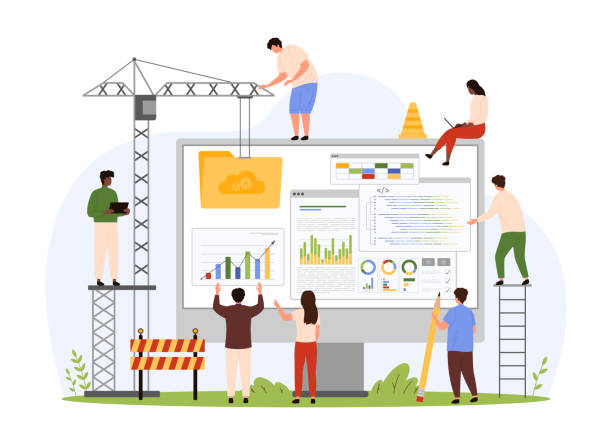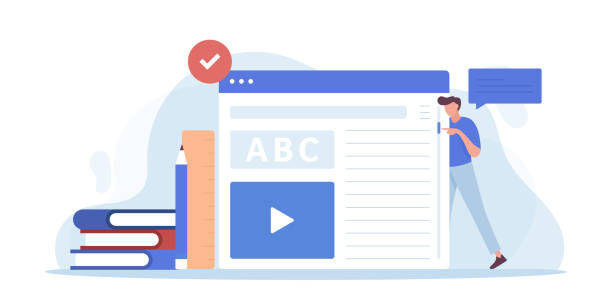An Introduction to User Interface and User Experience in Modern Web
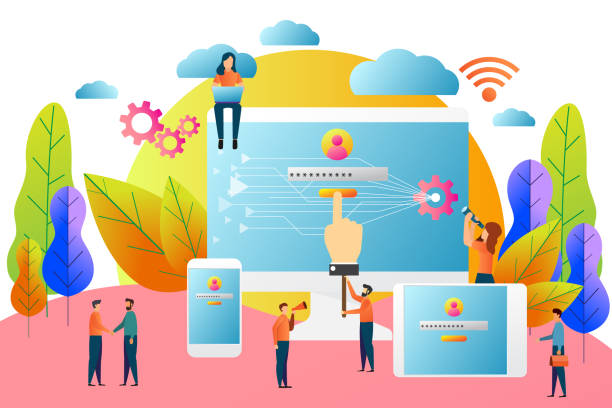
In today’s digital world, where competition to capture user attention intensifies by the moment, simply having a website is no longer enough for businesses.
A successful website is one that can provide a unique and enjoyable experience for its visitors.
This is where the concepts of #User_Interface (UI) and #User_Experience (UX) come into play.
User Interface refers to the appearance and visual interactions of a digital product, while User Experience encompasses all feelings, attitudes, and perceptions of an individual when using a product, system, or service.
In fact, modern UI website design means creating an environment that is not only beautiful and appealing, but also easy, enjoyable, and efficient to use.
A powerful UI, alongside an optimized UX, is the backbone of any successful website that aims to shine online and create meaningful interactions with its users.
This approach is particularly vital in designing new and up-to-date websites, as users expect to achieve their goals with minimum time and effort.
Therefore, every successful web design project begins by focusing on these two fundamental principles.
This not only leads to increased conversion rates and customer loyalty but also establishes your brand in users’ minds as a reputable and user-centric service provider.
This explanatory and educational section provides you with a general overview of the importance of this field, preparing you for the next steps.
Does your current e-commerce website design not generate the expected sales for you?
RasaWeb is specialized in professional e-commerce website design!
✅ An attractive and user-friendly website aiming to increase sales
✅ High speed and security for an ideal shopping experience⚡ Get free online store design consultation with RasaWeb!
Key Principles in Modern User Interface Design

To achieve a modern and effective UI website design, observing several key principles is essential.
These principles help designers create products that are both beautiful and easy and enjoyable to use.
One of the most important principles is “simplicity.”
The user interface should be free of any unnecessary complexity so that users can quickly and without confusion reach their goal.
“Consistency” is another important principle; design elements, interactive patterns, and visual language should be consistent and uniform across the website so that the user feels familiar and can predict outcomes.
The principle of “feedback” is highly important; the system should provide clear and immediate feedback in response to user actions, for example, by changing button color after a click or displaying a success message.
“Visual hierarchy” means organizing information so that the most important elements appear more prominent and capture the user’s attention.
Correct use of colors, fonts, and element sizes can be effective in this regard.
“Aesthetics” also plays a vital role; an attractive and pleasing user interface can improve the user experience and encourage them to stay on the site.
These specialized principles are the foundation of any successful UI design, and designers should always keep them in mind.
A website that adheres to these principles well is not only more efficient but also significantly helps increase user trust and loyalty.
These guidelines are essential for anyone intending to work professionally in the field of website design and can lead to a significant improvement in project quality.
The Importance of User Experience in Website Success
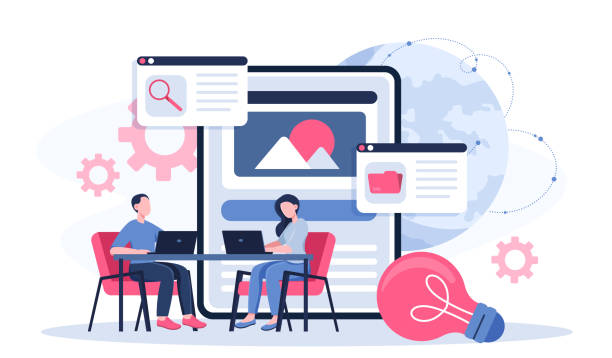
User Experience (UX) goes far beyond the visual aesthetics of a website; this concept encompasses all aspects of user interaction with your product or service.
In fact, a modern UI website design without a strong user experience is like a luxurious and beautiful car that is difficult and unpleasant to drive.
UX focuses on efficiency, ease of use, accessibility, and overall user satisfaction.
An optimized user experience can directly impact conversion rates, user retention time on the site, and customer loyalty.
When users can easily find the information they need, complete the purchasing process without problems, or quickly access their desired services, the likelihood of them returning to your site and recommending it to others significantly increases.
From an analytical perspective, websites with poor UX often face high bounce rates, decreased sales, and user dissatisfaction.
User experience is a continuous cycle of research, design, testing, and iteration, carried out with the aim of understanding user needs and behaviors.
These two concepts (UI and UX), although different, are inseparable and complement each other.
An excellent UI may not achieve its ultimate goal without good UX, and similarly, UX cannot establish effective communication with the user without an attractive UI.
Investing in UX means investing in customer satisfaction and, ultimately, the sustainable growth of your business.
This analytical section shows you why you should never overlook the deeper dimensions of user experience.
| Feature | User Interface (UI) | User Experience (UX) |
|---|---|---|
| Focus | Visual appearance and interactions (graphic design, layout, colors, fonts) | User feelings, functionality, ease of use (research, wireframing, user testing) |
| Goal | Aesthetics and visual interaction | Increase user satisfaction and efficiency |
| Tools | Figma, Sketch, Adobe XD, Photoshop | User journey map, user persona, usability tests |
| Main Question | How does it look? How do I interact with it? | How does the user feel? How easy and useful is it? |
| Example Output | Buttons, icons, images, animations | Optimized user journeys, seamless flows, overall satisfaction |
Tools and New Technologies in UI/UX Design

In the ecosystem of modern UI website design and user experience, access to appropriate tools can make a significant difference in project quality and speed.
Today, a wide range of software and frameworks are available to assist designers and developers.
For user interface design, tools like Figma, Sketch, and Adobe XD are leading.
Figma has rapidly gained popularity due to its cloud collaboration capabilities and ease of use, allowing designers to work simultaneously in a shared space.
Sketch remains a powerful UI design tool, especially for Mac users, and Adobe XD, as part of the Creative Cloud ecosystem, offers comprehensive tools for design and prototyping.
These tools enable wireframing, mockup, and prototyping, which are crucial for visualizing the design and initial testing with users.
In addition to design tools, front-end frameworks like React, Vue, and Angular also play a significant role in implementing modern user interfaces.
These frameworks, by providing reusable components and organized coding structures, help developers build complex and interactive user interfaces with high efficiency.
On the other hand, CSS frameworks like Tailwind CSS and Bootstrap, by offering a set of ready-to-use classes and default styles, accelerate the styling process and enable the creation of responsive designs.
The correct choice of tools and technologies based on project and team needs can significantly improve efficiency and final output.
This specialized guide helps you get acquainted with the latest tools.
Research shows that 80% of customers trust companies with a professional website more. Does your current website inspire this trust?
With RasaWeb’s corporate website design services, solve the problem of customer distrust and a weak online image forever!
✅ Create a professional image and increase customer trust
✅ Attract more sales leads and grow your business
⚡ Get free consultation
Responsive Design and Mobile-First Approach
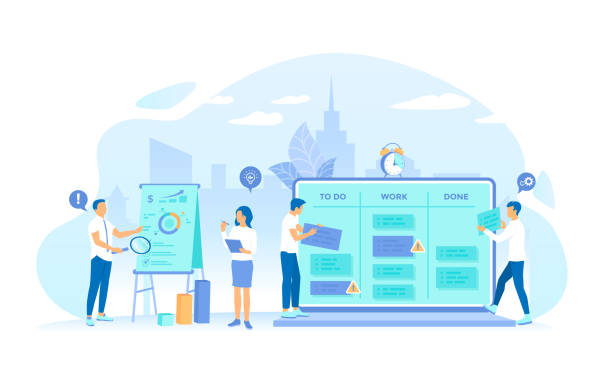
In the current era, where the majority of users connect to the internet via their mobile devices, Responsive Design and the Mobile-First approach are considered fundamental principles in modern UI website design.
Responsive design means creating a website that can automatically adapt its appearance and functionality to the screen size of the user’s device, from large desktops to tablets and small smartphones.
This approach ensures that users have a seamless and optimized experience, regardless of the device they use.
The importance of this issue is such that search engines like Google prefer responsive websites in their search rankings.
The mobile-first approach goes a step further; in this method, designers first start designing and developing the website for the smallest screen (usually mobile) and then gradually expand it for larger screens.
This ensures that from the outset, the focus is on essential content and core functionality, preventing the overloading of unnecessary elements for mobile users.
Techniques such as using Flexbox and CSS Grid in CSS enable the creation of flexible and complex layouts that easily adapt to changes in screen size.
Choosing appropriate fonts, images, and interactive elements is also crucial in this approach, as they must be optimized for various devices.
This educational and specialized approach ensures that your website is not only beautiful but also functional and accessible to everyone, optimizing the user experience across all platforms.
Accessibility and Inclusivity in User Interface Design

The concept of Accessibility in modern UI website design means that websites and applications should be designed in a way that all individuals, including those with physical, sensory, cognitive, or neurological disabilities, can easily use them.
This includes a wide range of users; from blind individuals who use screen readers to those with motor impairments who utilize keyboards or other assistive devices.
Accessibility is not just an ethical imperative but also a competitive advantage and, in many countries, even a legal requirement.
Websites that adhere to accessibility principles can reach a wider audience and improve the user experience for everyone.
The “Web Content Accessibility Guidelines” (WCAG) standards, developed by the World Wide Web Consortium (W3C), provide a comprehensive framework for this purpose.
Adherence to these standards includes providing alternative text (Alt Text) for images, using appropriate color contrast, enabling keyboard navigation, and designing accessible forms.
Web accessibility is not only for people with disabilities; it can also help users with slow internet speeds, older devices, or specific environmental conditions.
An inclusive and accessible design demonstrates your commitment to creating a digital space for everyone and enhances your brand’s reputation.
This explanatory and specialized section highlights the importance of an inclusive perspective in every web design project.
Testing, Evaluation, and Continuous Improvement of User Interface

After the completion of the initial design and development phase, the work of a modern UI website design does not end; in fact, this is where the crucial phase of testing, evaluation, and continuous improvement begins.
No design is perfect on the first try and requires real user feedback for optimization.
Usability Testing is one of the most effective methods for identifying weaknesses in the user interface and user experience.
In this process, real users perform specific tasks on the website, and designers and researchers observe their behavior, thoughts, and problems.
This educational and analytical approach provides deep insights into how users interact with the system.
Other methods, such as A/B testing, where two different versions of a page or element are shown to different groups of users to evaluate the performance of each, are also very effective in continuous improvement.
Gathering feedback through surveys, interviews, and analyzing analytical data (such as Google Analytics) also provides valuable information to designers.
This information helps identify user behavior patterns, exit points, and pages that need improvement.
The cycle of design, testing, evaluation, and improvement never stops; a successful website is constantly evolving and is updated based on changing user needs and expectations.
This iterative and data-driven approach ensures that your website is always aligned with user needs and provides a desirable experience.
Usability testing helps you identify and resolve issues before they lead to widespread dissatisfaction.
| Test Method | Description | Primary Application |
|---|---|---|
| Usability Testing | Observing real users while performing specific tasks on the product. | Identifying usability issues and user experience barriers. |
| A/B Testing | Comparing two versions (A and B) of a page or element to determine better performance. | Conversion rate optimization and data-driven decision making. |
| User Interviews | Direct conversation with users to understand needs, motivations, and pain points. | Gaining deep qualitative insights in the early design stages. |
| Surveys | Collecting quantitative and qualitative data from a large number of users through questionnaires. | Assessing general satisfaction, favorite features, or common issues. |
| Heatmaps | Visual representation of areas users click, move the mouse, or scroll most. | Analyzing user behavior on specific pages and identifying important elements. |
Future Trends in User Interface and User Experience Design
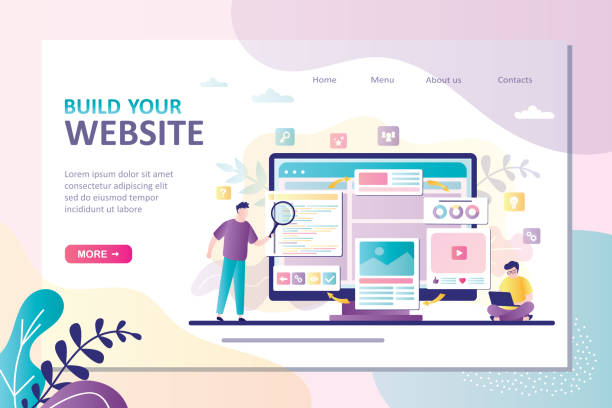
The world of modern UI website design and user experience is constantly evolving, and every year we witness the emergence of new trends that change how we interact with technology.
One of the most important future trends is the use of Artificial Intelligence (AI) in design processes.
AI-powered tools can help designers dedicate more time to creative and strategic aspects by automating repetitive tasks.
Also, AI can play a key role in personalizing user experience, allowing interfaces to dynamically change based on each user’s behavior and preferences.
Voice User Interfaces (Voice UI) are also rapidly growing, and it is expected that voice interaction with websites and applications will become a norm.
This brings new challenges and opportunities for designers.
Augmented Reality (AR) and Virtual Reality (VR) also have great potential to create fully immersive user experiences, especially in areas such as e-commerce, education, and entertainment.
Graphical user interface design will no longer be limited to two dimensions.
Furthermore, the focus on micro-interactions – small animated details that provide visual feedback to the user – will continue to create a more engaging and human experience.
Dark Mode and design styles such as Neumorphism also continue to be popular among users.
These trends are not just news but offer a deep analysis of the future of this field and indicate that designers must constantly update their knowledge to create the best experiences.
Does your current e-commerce website design cause customer and sales loss?
RasaWeb is your solution with modern and user-friendly e-commerce website designs!
✅ Significant increase in conversion rates and sales
✅ Building strong branding and gaining customer trust
⚡ Get free e-commerce website design consultation from RasaWeb!
Common Mistakes in UI/UX Design and Prevention Strategies

Even with the best intentions and technical knowledge, designers may make mistakes that harm the user experience and reduce the effectiveness of modern UI website design.
Recognizing these common mistakes and knowing how to prevent them is an important step towards improving the final product’s quality.
One of the common mistakes is a “cluttered and messy user interface.”
Placing too much information or too many interactive elements on a single page can confuse the user and prevent them from reaching their goal.
The solution is to adhere to the principle of simplicity and minimalism, displaying only essential information.
“Inconsistency in design” is also a common error; using different visual styles, inconsistent fonts, or non-uniform interactive patterns leads to user confusion and reduced trust.
“Ignoring user feedback” is a fatal mistake that can lead to designs that do not meet real user needs.
Instead of making assumptions, one should regularly conduct user tests and listen to feedback.
A “long website loading time” exhausts and frustrates users.
Optimizing images, code, and using fast servers can solve this problem.
“Complex and unintuitive navigation” is another weakness; users should be able to easily find their way around the site.
A clear and logical navigation structure is essential.
Web design mistakes can be costly.
“Lack of accessibility” is also a major flaw; designing a website that is not usable for people with disabilities not only limits the audience but may also have legal consequences.
By adhering to user-centric design principles, conducting regular tests, and paying attention to details, these mistakes can be prevented, and a better user experience can be provided.
This thought-provoking section makes you reflect on the challenges and practical solutions in UI/UX design.
Benefits of Investing in Modern User Interface Design

Investing in modern UI website design and optimized user experience is not just an expense but a strategic investment that can bring significant returns for any business.
One of the most prominent benefits is increased user satisfaction.
When users interact with your website easily and enjoyably, the likelihood of them becoming loyal customers significantly increases.
This directly leads to an increase in conversion rates, whether your goal is product sales, lead generation, or sign-ups.
An attractive and user-friendly interface establishes your brand in users’ minds as a modern and user-centric entity, which helps in strengthening brand identity.
In today’s competitive market, differentiation from competitors is crucial, and superior UI/UX can give you a significant competitive advantage.
Moreover, an optimized design can reduce customer support costs, as users encounter fewer problems and require less assistance.
Customer return rates increase, and users will be more inclined to recommend your website to others, which itself is a powerful form of word-of-mouth marketing.
Furthermore, websites with excellent UI/UX typically perform better in search engines, as low bounce rates and high dwell times are positive signals for SEO.
Ultimately, this investment not only leads to user satisfaction but also contributes to the sustainable growth and long-term success of your business.
This engaging and analytical section provides a comprehensive picture of the true value of UI/UX in today’s digital world.
Frequently Asked Questions
| Question | Answer |
|---|---|
| What is modern UI website design? | It is an approach to website design that focuses on clean aesthetics, simplicity, high usability, and providing a visually appealing and pleasant User Experience (UX). |
| What are the key elements of a modern web UI? | Flat Design, smart use of white space, attractive typography, intuitive navigation, high-quality images, and responsiveness are key elements. |
| Why is using a modern UI important in website design? | It attracts and retains users, enhances brand credibility, improves conversion rates, and provides a smooth and pleasant user experience. |
| How does modern User Interface (UI) affect User Experience (UX)? | Modern UI directly improves user experience by creating a beautiful, organized, and understandable environment, making interaction easier. |
| What is the role of typography in modern UI design? | Typography is crucial for readability, creating information hierarchy, conveying brand personality, and the overall visual appeal of the site. |
| How is Responsive Design related to modern UI? | Responsive design is an integral part of modern UI, as it ensures that the site’s appearance and functionality are consistent and optimal across all devices (mobile, tablet, desktop). |
| What are the current trends in modern web UI design? | Dark Mode, subtle animations, creative use of white space, prominent typography, and asymmetric graphic elements are among recent trends. |
| How can one ensure that modern UI has high Usability? | By conducting user testing, simplifying navigation, providing clear Calls to Action (CTAs), improving loading speed, and focusing on Accessibility. |
| What is the main difference between UI and UX in modern design? | UI is the look and feel of the site (user interface), while UX is the overall user experience when interacting with the site. UI is considered a part of UX. |
| What tools are used for modern web UI design? | Common tools such as Figma, Sketch, Adobe XD, Photoshop, and Illustrator are used for modern UI design and prototyping. |
And other services of Rasa Web Advertising Agency in the field of advertising
Smart Customer Journey Map: A fast and efficient solution to increase sales with a focus on custom programming.
Smart Advertising Campaign: Professional optimization for user engagement using precise audience targeting.
Smart Website Development: A creative platform to improve sales growth with intelligent data analysis.
Smart Customer Journey Map: A creative platform to improve campaign management with marketing automation.
Smart Marketing Automation: A fast and efficient solution to increase sales with a focus on attractive user interface design.
And over hundreds of other services in the field of internet advertising, advertising consultation, and organizational solutions
Internet Advertising | Advertising Strategy | Advertorial
Sources
Comprehensive Website Design Guide
Principles of Modern User Interface Design
Key Tips for User Experience Optimization
Introduction to Front-End Basics and Responsive Design
In RasaWeb Afarin Digital Marketing Agency, your online dream becomes a reality! We bring your business to the peak of success by offering services such as custom website design, professional SEO, and social media management. Contact us today for a free consultation and build your digital future.
📍 Tehran, Mirdamad Street, next to Bank Markazi, Southern Kazeroon Alley, Ramin Alley, Plaque 6


